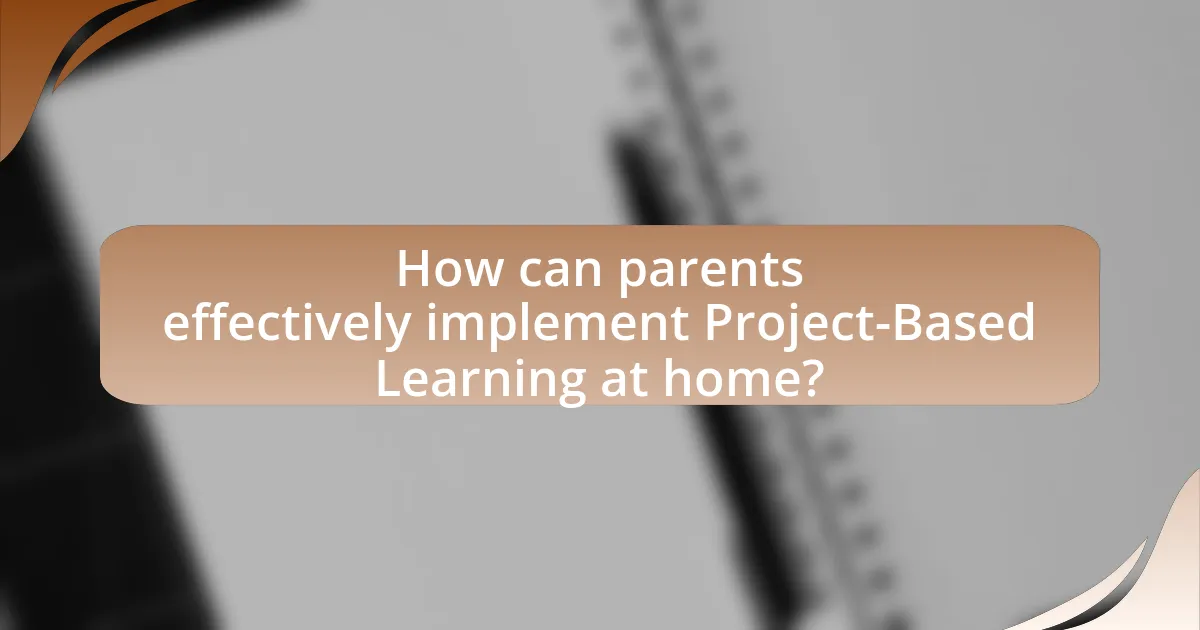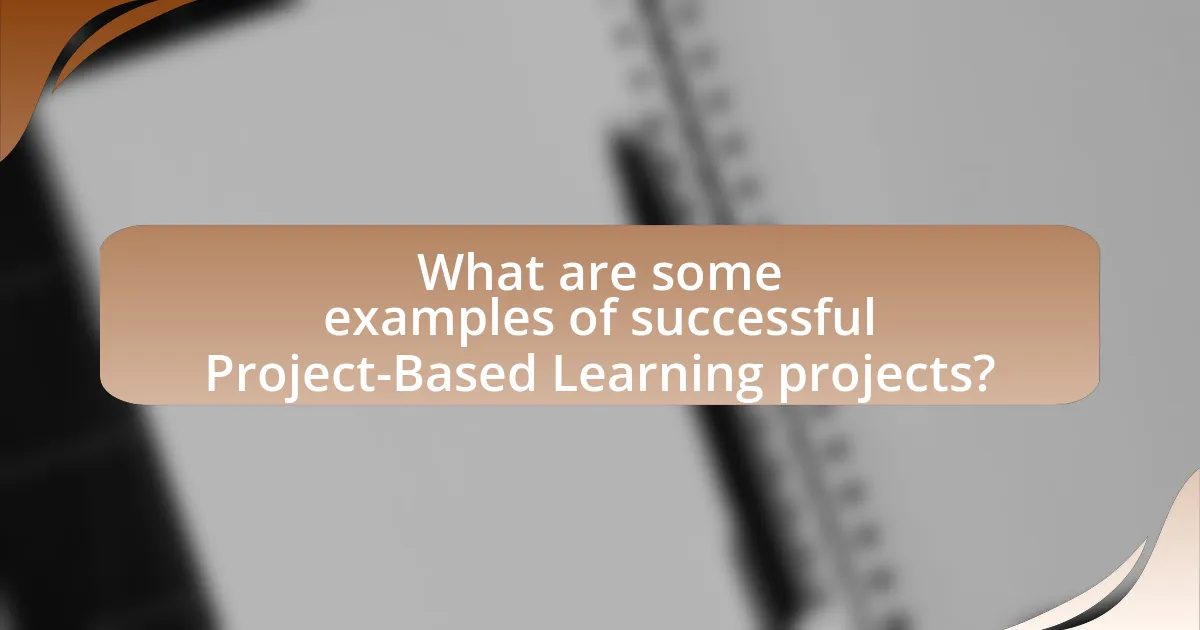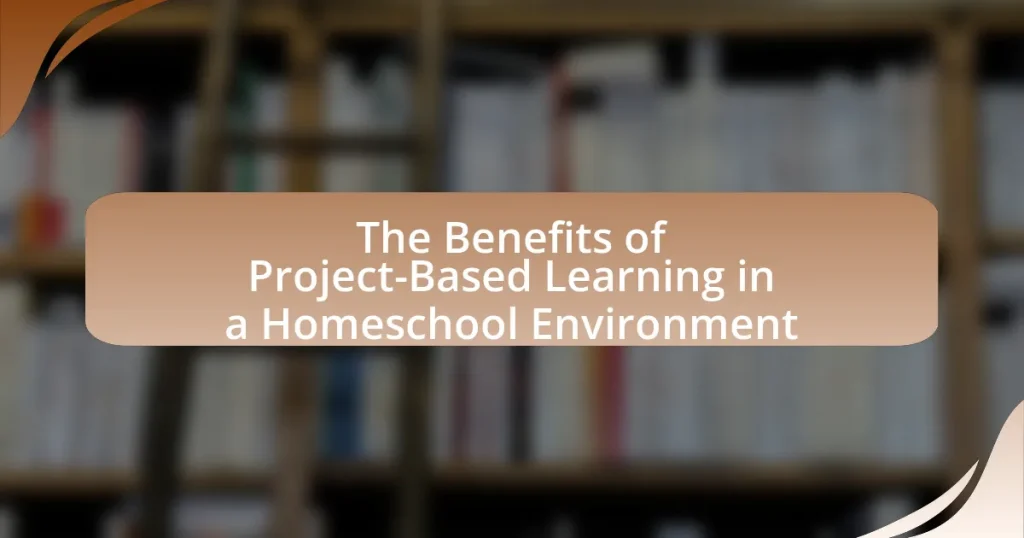Project-Based Learning (PBL) in a homeschool environment is an educational approach that emphasizes hands-on projects integrating various subjects and skills, fostering active learning and critical thinking. This article explores the differences between PBL and traditional learning methods, highlighting key characteristics such as student-centered learning, real-world relevance, and collaboration. It also discusses how the homeschooling context enhances PBL by allowing personalized learning experiences, the importance of student choice, and the benefits of collaboration. Additionally, the article provides strategies for parents to implement PBL effectively at home, assess student progress, and overcome common challenges, ultimately demonstrating how PBL promotes engagement, motivation, and critical thinking skills in students.

What is Project-Based Learning in a Homeschool Environment?
Project-Based Learning (PBL) in a homeschool environment is an educational approach where students engage in hands-on projects that integrate various subjects and skills. This method emphasizes active learning, allowing students to explore real-world problems and develop solutions through research, collaboration, and critical thinking. Research indicates that PBL enhances student engagement and retention of knowledge, as it encourages learners to take ownership of their education by applying concepts in practical contexts. Studies, such as those conducted by the Buck Institute for Education, show that students involved in PBL demonstrate improved problem-solving abilities and higher levels of motivation compared to traditional learning methods.
How does Project-Based Learning differ from traditional learning methods?
Project-Based Learning (PBL) differs from traditional learning methods by emphasizing hands-on, real-world projects as the primary mode of instruction, rather than rote memorization and standardized testing. In PBL, students engage in collaborative, interdisciplinary projects that require critical thinking, problem-solving, and creativity, fostering deeper understanding and retention of knowledge. Research indicates that PBL enhances student engagement and motivation, with studies showing that students in PBL environments often outperform their peers in traditional settings on assessments of understanding and application of knowledge. For instance, a study published in the “Journal of Educational Psychology” by Thomas Markham found that students involved in PBL demonstrated higher levels of achievement and retention compared to those in conventional classrooms.
What are the key characteristics of Project-Based Learning?
Project-Based Learning (PBL) is characterized by its focus on student-centered, inquiry-based learning through real-world projects. In PBL, students engage in complex tasks that require critical thinking, collaboration, and communication, allowing them to explore and apply knowledge in practical contexts. Research indicates that PBL enhances student motivation and retention of information, as students are more likely to remember what they learn when they apply it to meaningful projects. Additionally, PBL fosters skills such as problem-solving and self-directed learning, which are essential for success in both academic and real-life situations.
How does the homeschooling context influence Project-Based Learning?
The homeschooling context significantly enhances Project-Based Learning (PBL) by allowing for personalized learning experiences tailored to individual student interests and learning styles. In a homeschool setting, parents can design projects that align closely with their child’s passions, fostering deeper engagement and motivation. Research indicates that personalized learning approaches, such as those found in homeschooling, lead to improved academic outcomes and higher levels of student satisfaction. For instance, a study by the National Center for Education Statistics found that homeschooled students often outperform their peers in traditional schools on standardized tests, highlighting the effectiveness of customized educational strategies like PBL in a homeschooling environment.
What are the core principles of Project-Based Learning?
The core principles of Project-Based Learning (PBL) include student-centered learning, real-world relevance, collaborative work, and reflective practice. Student-centered learning emphasizes active engagement, allowing learners to take ownership of their educational journey. Real-world relevance connects projects to authentic issues or challenges, enhancing motivation and applicability. Collaborative work fosters teamwork and communication skills, as students often work in groups to solve problems. Reflective practice encourages students to assess their learning processes and outcomes, promoting deeper understanding and continuous improvement. These principles are supported by educational research, such as the study by Thomas Markham, which highlights the effectiveness of PBL in developing critical thinking and problem-solving skills.
Why is student choice important in Project-Based Learning?
Student choice is important in Project-Based Learning because it enhances engagement and ownership of the learning process. When students have the autonomy to select topics or projects that resonate with their interests, they are more likely to invest time and effort into their work, leading to deeper understanding and retention of knowledge. Research indicates that student agency in learning fosters intrinsic motivation, which is crucial for effective learning outcomes. For instance, a study by Patall, Cooper, and Robinson (2008) published in the Journal of Educational Psychology found that providing students with choices significantly improved their motivation and academic performance. Thus, allowing student choice in Project-Based Learning not only promotes engagement but also supports better educational results.
How does collaboration enhance the learning experience?
Collaboration enhances the learning experience by fostering critical thinking, communication skills, and deeper understanding of concepts. When learners work together, they engage in discussions that challenge their perspectives, leading to more comprehensive knowledge retention. Research indicates that collaborative learning can improve academic performance; for instance, a study published in the “Journal of Educational Psychology” by Johnson and Johnson found that students in collaborative settings scored higher on assessments compared to those who learned individually. This evidence supports the notion that collaboration not only enriches the learning process but also equips students with essential skills for future success.
What benefits does Project-Based Learning provide in a homeschool setting?
Project-Based Learning (PBL) in a homeschool setting enhances student engagement and fosters critical thinking skills. This approach allows learners to explore real-world problems and develop solutions, promoting deeper understanding and retention of knowledge. Research indicates that students involved in PBL demonstrate improved collaboration and communication skills, as they often work in teams to complete projects. Additionally, PBL encourages self-directed learning, enabling students to take ownership of their education and pursue their interests, which can lead to increased motivation and satisfaction in learning.
How does it promote critical thinking and problem-solving skills?
Project-Based Learning (PBL) promotes critical thinking and problem-solving skills by engaging students in real-world projects that require them to analyze information, make decisions, and develop solutions. In a homeschool environment, PBL encourages learners to explore topics deeply, fostering inquiry and reflection, which are essential components of critical thinking. Research by Thomas Markham in “Project Based Learning: A Bridge Just Far Enough” highlights that students involved in PBL demonstrate improved analytical skills and creativity as they navigate complex problems, collaborate with peers, and apply knowledge in practical contexts. This hands-on approach not only enhances their ability to think critically but also equips them with the problem-solving skills necessary for future challenges.
What impact does it have on student engagement and motivation?
Project-Based Learning (PBL) significantly enhances student engagement and motivation. This educational approach fosters active participation by allowing students to explore real-world problems, which increases their intrinsic motivation to learn. Research indicates that students involved in PBL demonstrate higher levels of engagement, as they take ownership of their learning process and collaborate with peers. A study by Thomas Markham in “Project Based Learning Handbook” highlights that students in PBL environments show improved motivation due to the relevance and authenticity of the projects they undertake. This connection to real-life applications not only sustains their interest but also encourages deeper learning and retention of knowledge.

How can parents effectively implement Project-Based Learning at home?
Parents can effectively implement Project-Based Learning (PBL) at home by selecting engaging, real-world projects that align with their children’s interests and educational goals. This approach encourages active learning and critical thinking, as children work on projects that require problem-solving and collaboration. For instance, parents can facilitate a project where children design a small garden, integrating lessons on biology, math, and environmental science. Research shows that PBL enhances student engagement and retention of knowledge, as evidenced by a study published in the “Journal of Educational Psychology,” which found that students involved in PBL scored higher on assessments compared to traditional learning methods. By providing resources, guidance, and opportunities for reflection, parents can create a supportive environment that fosters creativity and deeper understanding through PBL.
What strategies can parents use to design effective projects?
Parents can design effective projects by incorporating clear objectives, relevant themes, and hands-on activities. Establishing specific learning goals ensures that projects align with educational standards and student interests. Selecting themes that resonate with students enhances engagement, while hands-on activities promote active learning and skill development. Research indicates that project-based learning increases retention and understanding, as evidenced by a study from the Buck Institute for Education, which found that students involved in project-based learning scored higher on assessments compared to traditional learning methods.
How can parents assess student progress in Project-Based Learning?
Parents can assess student progress in Project-Based Learning by utilizing specific evaluation methods such as rubrics, self-assessments, and regular feedback sessions. Rubrics provide clear criteria for evaluating student work, allowing parents to measure progress against defined learning objectives. Self-assessments encourage students to reflect on their own learning and identify areas for improvement, fostering a sense of ownership over their education. Regular feedback sessions between parents and students facilitate open communication about challenges and successes, enabling parents to track development over time. These methods collectively ensure that parents have a comprehensive understanding of their child’s progress in a Project-Based Learning environment.
What resources are available to support Project-Based Learning?
Resources available to support Project-Based Learning (PBL) include online platforms, community organizations, and educational materials. Online platforms such as Edutopia and the Buck Institute for Education provide comprehensive guides, project ideas, and best practices for implementing PBL. Community organizations often offer workshops and resources that facilitate real-world projects, enhancing student engagement. Additionally, educational materials like project kits and curriculum guides from publishers such as Teachers Pay Teachers and Scholastic can provide structured support for PBL initiatives. These resources collectively enhance the effectiveness of PBL in a homeschool environment by offering diverse tools and collaborative opportunities.
What challenges might parents face when using Project-Based Learning?
Parents may face several challenges when using Project-Based Learning (PBL), including time management, resource allocation, and assessment difficulties. Time management becomes a significant issue as PBL often requires extensive planning and execution, which can be challenging for parents balancing multiple responsibilities. Resource allocation poses another challenge, as parents may struggle to find appropriate materials and tools necessary for effective project implementation. Additionally, assessing student progress in PBL can be complex, as traditional grading methods may not adequately reflect a child’s learning and skills development. These challenges highlight the need for parents to develop strategies to effectively navigate the PBL approach in a homeschool environment.
How can parents overcome common obstacles in project implementation?
Parents can overcome common obstacles in project implementation by establishing clear communication and setting realistic expectations. Effective communication ensures that all family members understand their roles and responsibilities, which minimizes confusion and enhances collaboration. Setting realistic expectations helps in managing time and resources effectively, allowing parents to allocate appropriate time for project tasks without overwhelming their children. Research indicates that structured planning and regular check-ins can significantly improve project outcomes, as evidenced by studies showing that families who engage in consistent project reviews report higher satisfaction and success rates in homeschooling environments.
What are some tips for maintaining student motivation during projects?
To maintain student motivation during projects, it is essential to set clear goals and provide regular feedback. Clear goals help students understand what is expected of them, while regular feedback keeps them engaged and informed about their progress. Research indicates that students are more motivated when they can see the relevance of their work; thus, connecting projects to real-world applications enhances their interest and commitment. Additionally, incorporating student choice in project topics fosters ownership and intrinsic motivation, as students are more likely to engage deeply with subjects they are passionate about.

What are some examples of successful Project-Based Learning projects?
Successful Project-Based Learning projects include the “Water Filtration Project,” where students design and build water filtration systems to understand environmental science and engineering principles. Another example is the “Community Garden Project,” where learners plan, plant, and maintain a garden, promoting teamwork and biology concepts. The “History Documentary Project” allows students to research and create documentaries on historical events, enhancing their research and storytelling skills. These projects have shown to improve critical thinking, collaboration, and real-world problem-solving abilities in students, as evidenced by studies indicating increased engagement and retention of knowledge in project-based learning environments.
How can real-world problems be integrated into projects?
Real-world problems can be integrated into projects by designing assignments that reflect actual challenges faced in society, such as environmental issues, social justice, or community needs. This approach allows students to apply theoretical knowledge to practical situations, enhancing their problem-solving skills and engagement. For instance, a project could involve students developing a plan to reduce waste in their community, which not only teaches them about environmental science but also encourages civic responsibility. Research shows that project-based learning, which incorporates real-world problems, significantly improves student motivation and retention of knowledge, as evidenced by a study conducted by Thomas Markham in 2011, highlighting the effectiveness of this educational strategy in fostering critical thinking and collaboration among students.
What are some interdisciplinary project ideas for homeschoolers?
Interdisciplinary project ideas for homeschoolers include creating a community garden, developing a historical documentary, and designing a science experiment that explores environmental issues. A community garden project integrates biology, ecology, and nutrition, allowing students to learn about plant life cycles, ecosystems, and healthy eating. Developing a historical documentary combines research skills, storytelling, and technology, enabling students to explore historical events and their impacts. Designing a science experiment focused on environmental issues, such as water quality testing, merges scientific inquiry with social studies, fostering critical thinking about real-world problems. These projects promote engagement and deeper understanding across multiple subjects, enhancing the educational experience in a homeschool setting.
How can technology be utilized in Project-Based Learning projects?
Technology can be utilized in Project-Based Learning (PBL) projects by facilitating collaboration, enhancing research capabilities, and providing access to diverse resources. For instance, online platforms like Google Classroom and Microsoft Teams enable students to work together in real-time, share documents, and communicate effectively, which is essential for successful project completion. Additionally, technology allows students to access a vast array of information and tools, such as databases, educational websites, and multimedia resources, which can enrich their learning experience and support their project objectives. Research indicates that integrating technology in PBL can lead to improved student engagement and learning outcomes, as evidenced by a study published in the Journal of Educational Technology & Society, which found that technology-enhanced PBL environments significantly increased student motivation and achievement.
What best practices should parents follow for successful Project-Based Learning?
Parents should encourage active engagement and collaboration in Project-Based Learning (PBL) to ensure its success. This involves facilitating open communication, allowing children to express their ideas, and promoting teamwork among peers. Research indicates that students who collaborate on projects demonstrate improved problem-solving skills and higher retention of knowledge, as highlighted in the study “The Impact of Collaborative Learning on Student Engagement” by Johnson and Johnson (2014). Additionally, parents should provide resources and guidance while allowing children the autonomy to explore their interests, which fosters intrinsic motivation and creativity. By balancing support with independence, parents can enhance the effectiveness of PBL in a homeschool environment.
How can parents create a supportive learning environment at home?
Parents can create a supportive learning environment at home by establishing a dedicated space for learning, setting a consistent schedule, and encouraging open communication. A designated area minimizes distractions and signals to children that it is time to focus on their studies. Research indicates that structured routines enhance academic performance, as they help children develop time management skills and a sense of responsibility. Additionally, fostering open communication allows parents to understand their children’s needs and interests, which can lead to more effective and engaging project-based learning experiences.
What role does reflection play in the learning process?
Reflection plays a crucial role in the learning process by enabling learners to critically assess their experiences and integrate new knowledge. This self-assessment fosters deeper understanding and retention of information, as learners can identify what strategies worked, what didn’t, and how they can improve in future tasks. Research indicates that reflective practices enhance metacognitive skills, allowing students to become more self-directed and effective in their learning. For instance, a study published in the Journal of Educational Psychology found that students who engaged in reflective practices demonstrated higher academic performance and greater motivation compared to those who did not.










